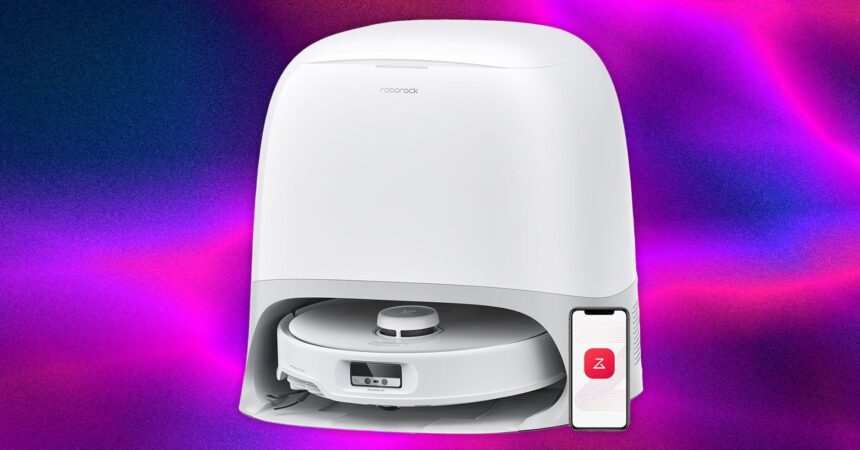Alternative Robot Vacuums Worth Considering
We are nearing the peak of the robot vacuum revolution. Regardless of your budget, you can discover a robot vacuum that appears quite similar and offers comparable features. Here are several options that performed admirably for us.
Roborock Qrevo Curv at $1,300: This was Roborock’s flagship vacuum for 2024, and it remains an excellent choice (reviewer Ryan Waniata describes it as the best robot vacuum he has ever used). It boasts slightly less suction power than this year’s Saros 10R, yet it effectively tackled an entire carpet coated in baking powder.
Eufy Mach S1 Pro at $1,200: This remarkably stunning robot vacuum is bound to be the highlight of your kitchen. It features a transparent water chamber that lights up and an ozone generator that purportedly eliminates up to 99.99 percent of bacteria. It also comes equipped with precise navigation and a self-cleaning roller mop. However, it offers only 8,000 Pa suction power, which is lower than some other models, and its 26.4-inch high docking station can make storage a bit challenging.
iRobot Roomba 694 for $275: The term Roomba has become synonymous with robot vacuums, and while newer versions may not provide as much value, the older models remain excellent and affordable. Even the most basic versions have features like Dirt Detect, which spot-cleans specific areas. The accompanying app is straightforward and user-friendly, complemented by a quiet yet powerful vacuum.
Eufy X10 Pro Omni for $700: Surprisingly, this price is reasonable for a hybrid robot vacuum-mop (9/10, WIRED Recommends) with exceptional navigational skills! (Promotions have made it even more affordable.) Nevertheless, the Yeedi mentioned earlier is less expensive and provides a lot of the same functionalities.
Dreame L40 Ultra at $1,500: The Dreame robot vacuum-mop combo made its debut at IFA 2024. It is slightly cheaper than the Dreame X30 Ultra (7/10, WIRED Review), but it lacks the ability to remove its mop pads, a feature that users appreciated in the more expensive model. Reviewer Nena Farrell noted that despite being more affordable, it still carries a hefty price tag, and it occasionally bumped into things more often than the X30. Nonetheless, it is visually appealing and retains plenty of battery life after both mopping and vacuuming tasks.
Robot Vacuums to Avoid
Not all robot vacuums merit a mention on our list. Here are the ones I quickly returned.
TP-Link Tapo RV30C at $229: I appreciate the straightforward design of this robot vacuum, but replacement bags have become increasingly hard to find.
Eureka J20 and Eureka J15 Pro Ultra at $850: Eureka is a well-respected brand in the vacuum industry, and these models are visually appealing and come loaded with features. However, neither model could overcome the small transition from my kitchen’s hardwood floor to the living room carpet, and the app consistently forgot the layout each time it encountered a minor hurdle. It was incredibly frustrating.
Proscenic M9 for £439: Reviewer Simon Hill declared this robot vacuum to be subpar. It often misses cleaning spots, the chute quickly clogs with hair, and it generates constant noise. When it gets trapped, it advises you to contact customer support. The only positive aspect is that it appears to be currently out of stock.
Narwal Freo X Ultra for $1,400: This robot vacuum is quite attractive and features numerous functions, including baseboard dusting. However, despite attempting to connect to the app in multiple rooms for better Wi-Fi reception and trying various phones with different app versions, I was unable to link it. (I reached out to Narwal several times but couldn’t resolve the issue; we will update if a solution is found later.)
Switchbot K10+ at $600: WIRED reviewer Simon Hill also tested this robot vacuum, which, while adorable (half the size of a typical vacuum), exhibited hazardous behavior. The roller frequently clogs, it struggles to return to the dock, and it often tumbles down the stairs.
Shark PowerDetect 2-in-1 for $1,000: This vacuum performed surprisingly well (5/10, WIRED Review). However, it doesn’t feature auto-empty functionality, the DirtDetect feature fails to work, and the accompanying app presents numerous issues (inaccurate maps, inability to add multiple floors, and incorrect cleaning time estimates).










